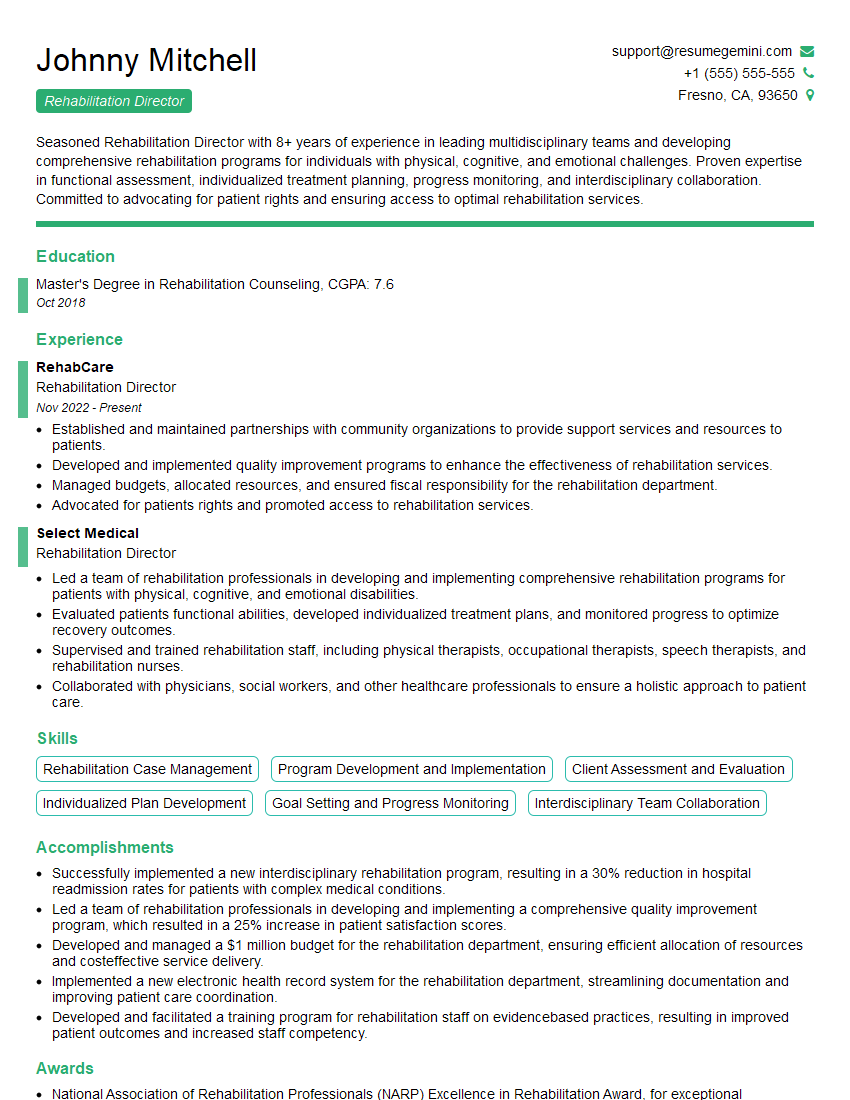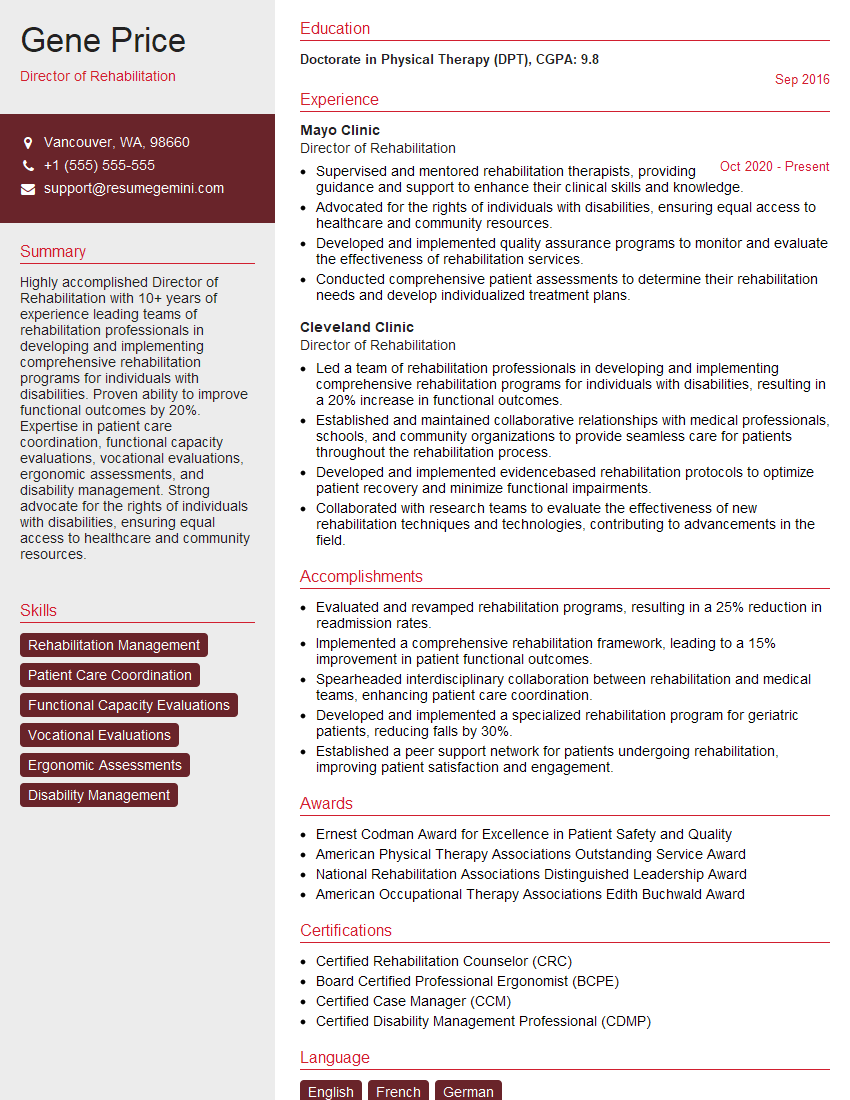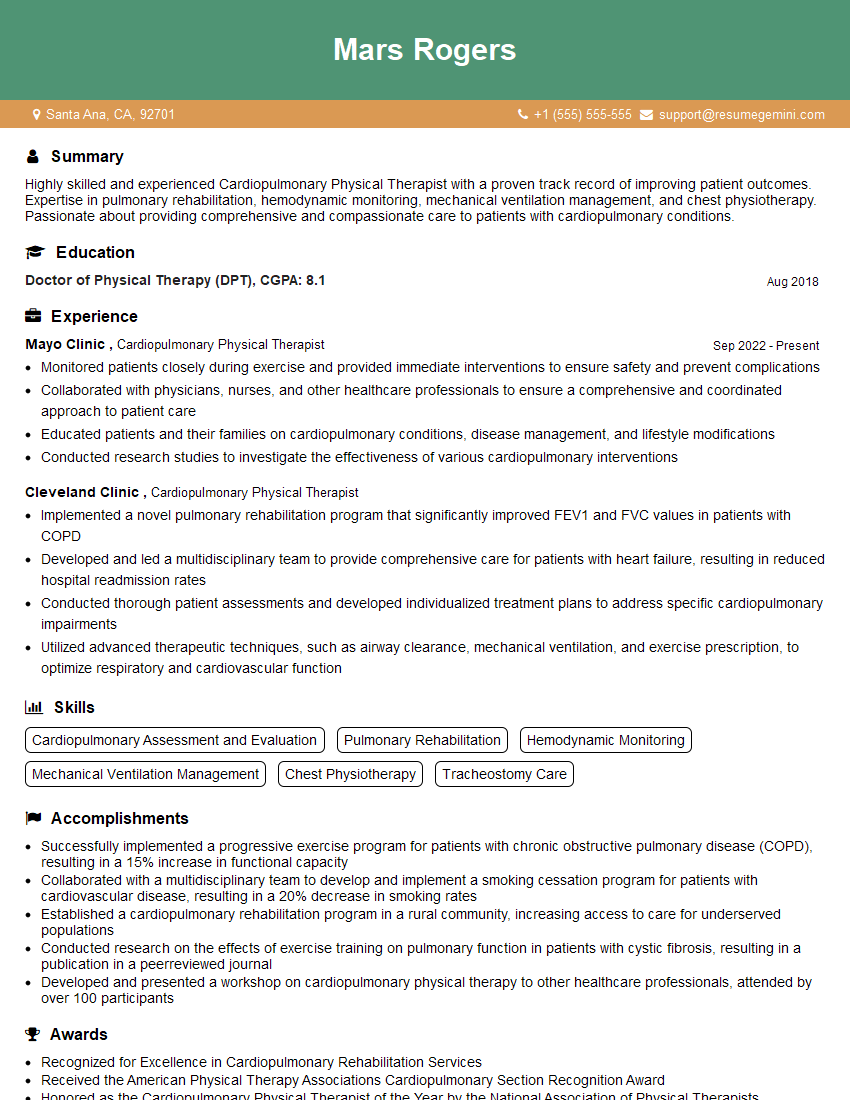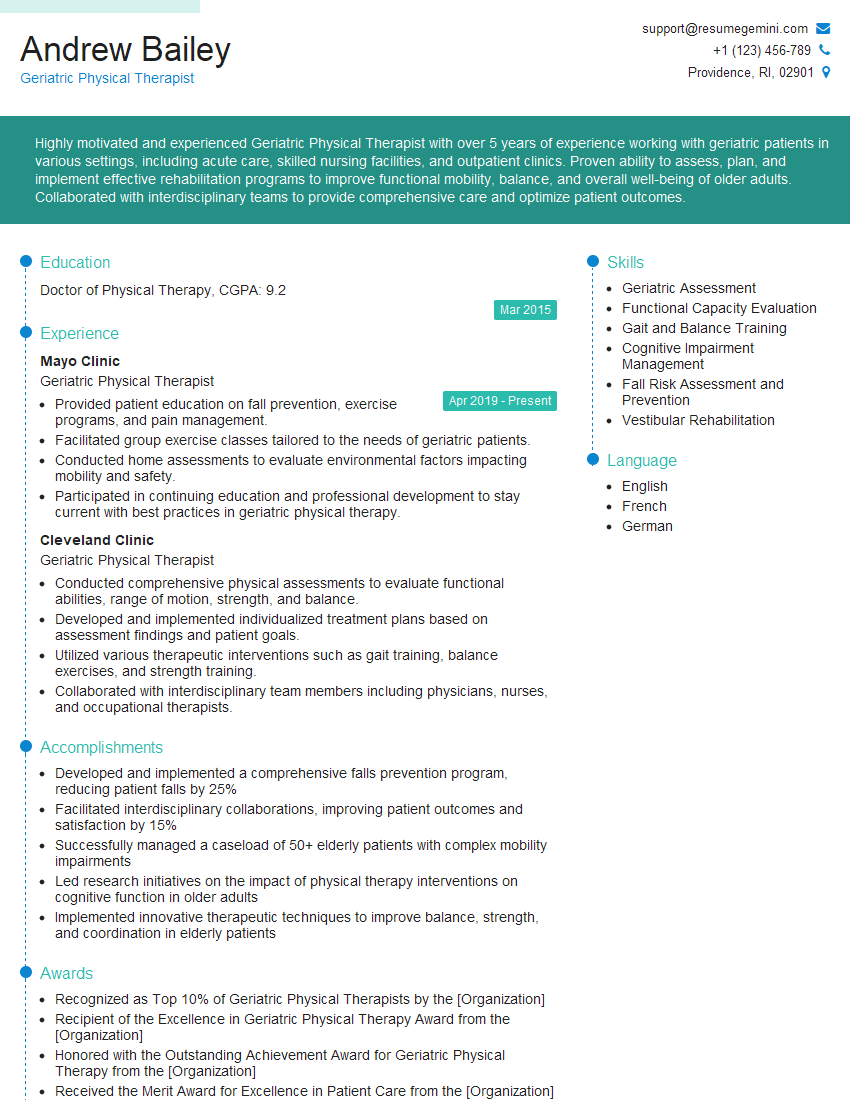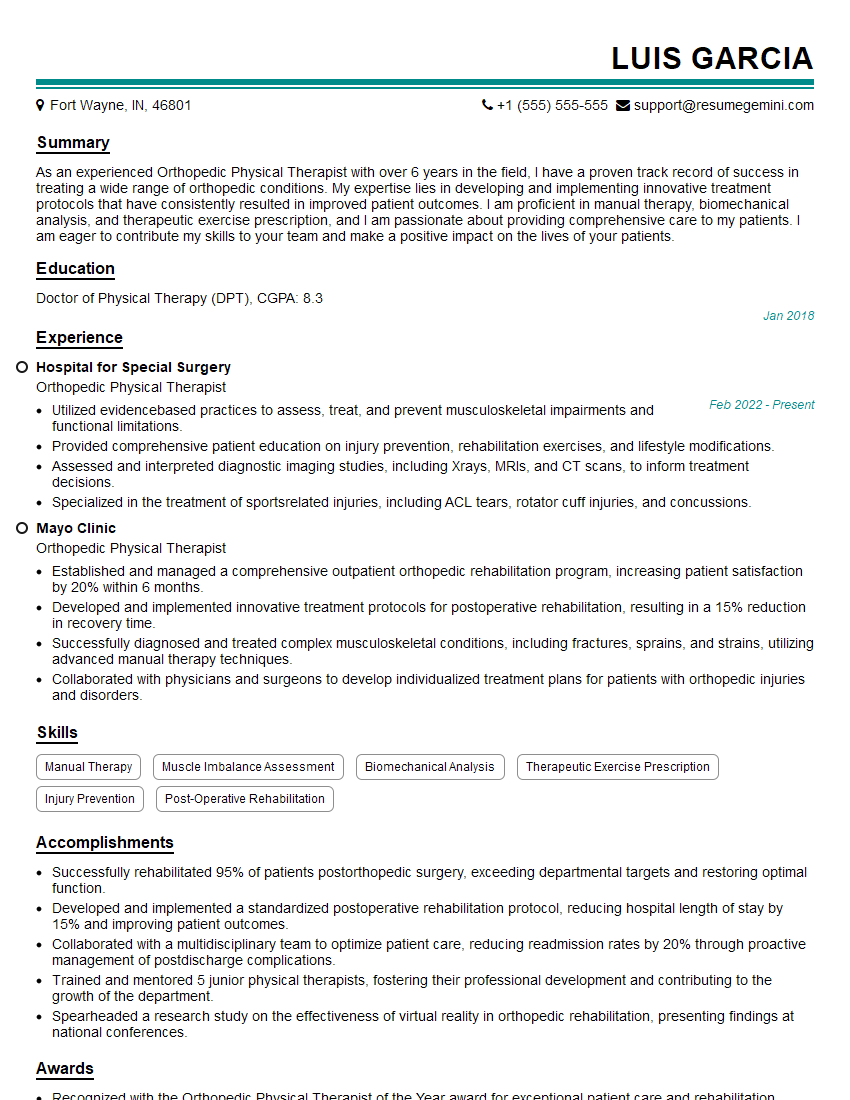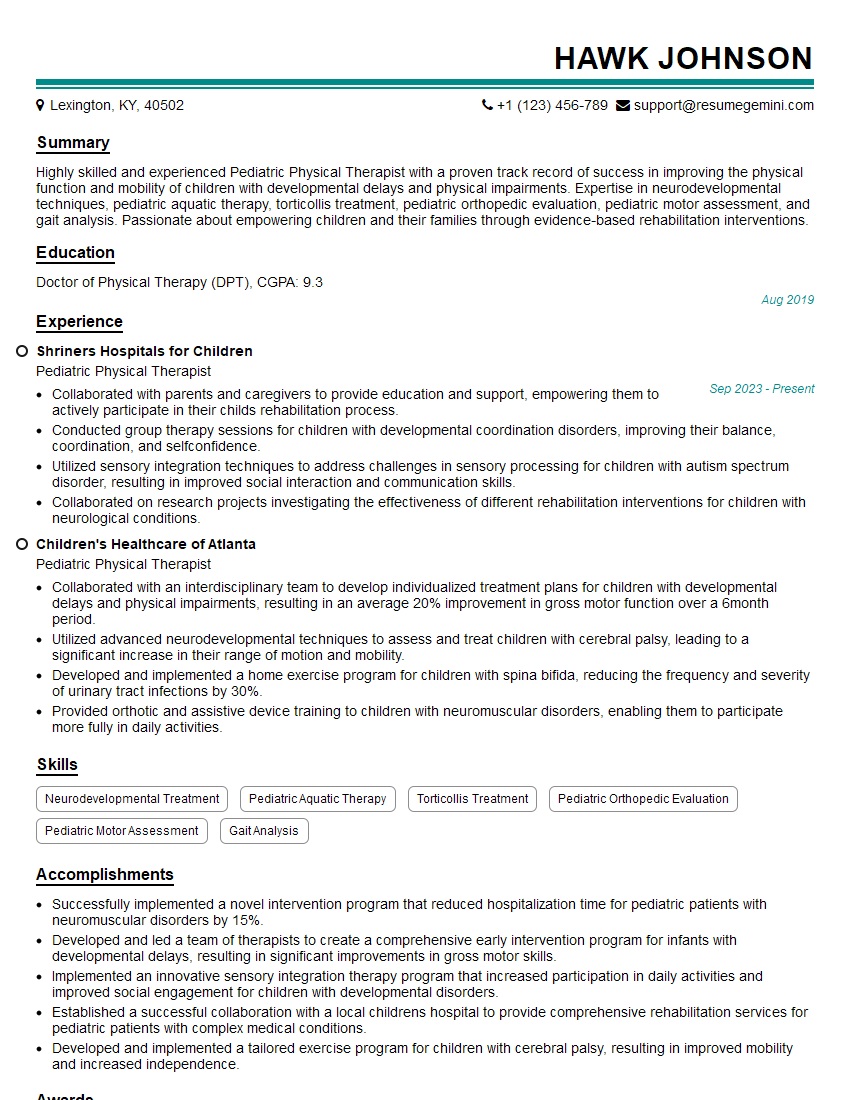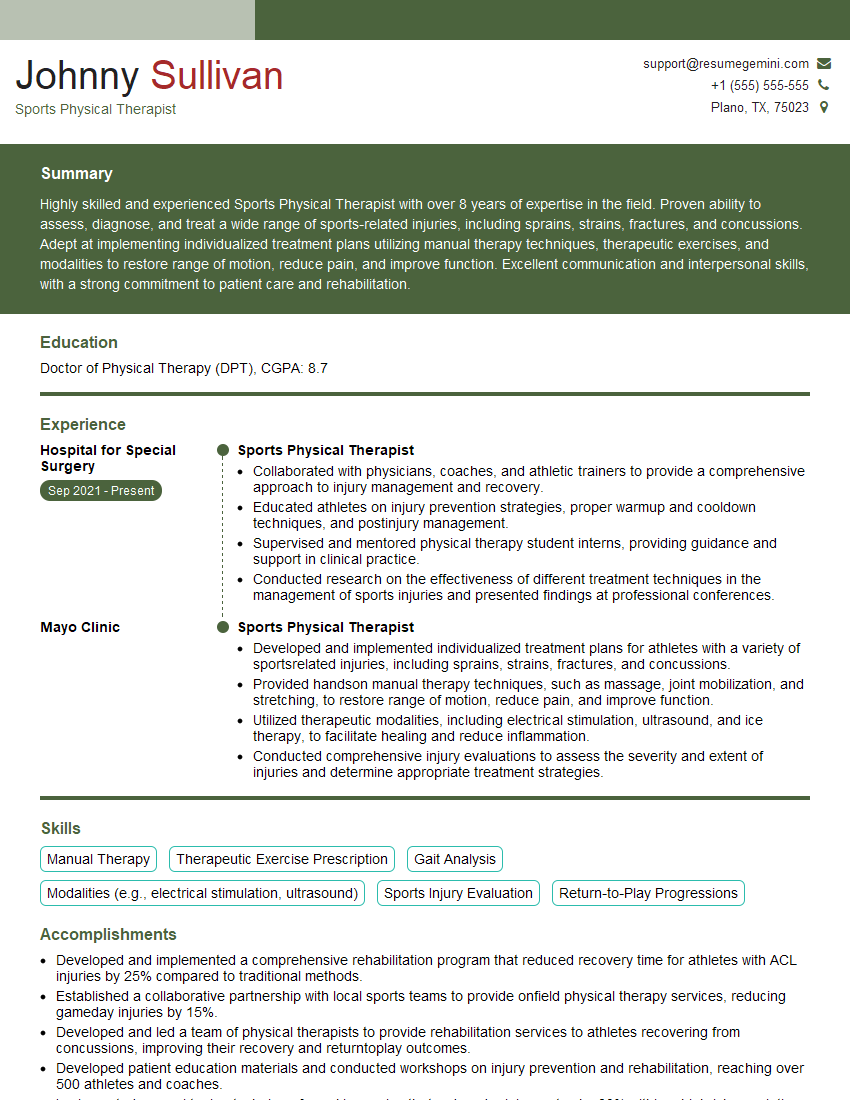Every successful interview starts with knowing what to expect. In this blog, we’ll take you through the top Physical Therapy Techniques interview questions, breaking them down with expert tips to help you deliver impactful answers. Step into your next interview fully prepared and ready to succeed.
Questions Asked in Physical Therapy Techniques Interview
Q 1. Describe your experience with manual therapy techniques.
Manual therapy is a cornerstone of my practice, encompassing a wide range of hands-on techniques to diagnose and treat musculoskeletal impairments. My experience includes soft tissue mobilization, joint mobilization/manipulation, muscle energy techniques, and myofascial release. For example, I frequently use soft tissue mobilization to address muscle tightness and trigger points in patients with low back pain. This might involve techniques like deep tissue massage or cross-fiber friction to break up adhesions and improve tissue extensibility. Joint mobilization, on the other hand, is used to restore joint mechanics and improve range of motion, often employed in patients with limited shoulder mobility after a rotator cuff injury. My approach is always patient-centered, carefully selecting techniques based on individual needs and assessment findings.
I also incorporate muscle energy techniques, where I use the patient’s own muscle contractions to improve joint alignment and reduce pain. For instance, a patient with temporomandibular joint (TMJ) dysfunction might benefit from gentle isometric contractions of the jaw muscles guided by my hands, helping to release tension and improve jaw function. Finally, myofascial release aims to address restrictions in the fascia, the connective tissue surrounding muscles and organs. This technique involves slow, sustained pressure to release fascial tension and improve mobility. Through a combination of these approaches, tailored to each individual, I aim to restore optimal movement and reduce pain.
Q 2. Explain the difference between Type I and Type II muscle fibers and their relevance to rehabilitation.
Type I and Type II muscle fibers are the two main types of skeletal muscle fibers, differing significantly in their contractile properties and metabolic characteristics. Type I, or slow-twitch fibers, are characterized by their slow contraction speed, high endurance, and reliance on aerobic metabolism. Think of marathon runners – their leg muscles are predominantly Type I. They’re fatigue-resistant and ideal for sustained activities. Type II, or fast-twitch fibers, are further subdivided into Type IIa and Type IIb (or Type IIx). Type IIa fibers contract faster than Type I, have moderate endurance, and use both aerobic and anaerobic metabolism. Type IIb fibers contract fastest, have low endurance, and rely heavily on anaerobic metabolism – think sprinters, where explosive power is critical.
In rehabilitation, understanding these fiber types is crucial. For example, when designing a program for a patient recovering from a knee injury, we’d consider the patient’s functional demands. For activities like walking, which requires endurance, we would focus on exercises targeting Type I fibers through longer duration, low intensity activities. For activities requiring power, such as jumping or quickly changing direction, we would incorporate exercises that emphasize Type II fiber recruitment, utilizing higher intensity, shorter duration activities. Knowing the fiber type profile is essential to designing safe and effective rehabilitation programs.
Q 3. How do you assess a patient’s gait and identify gait deviations?
Gait assessment is a systematic process of observing and analyzing a patient’s walking pattern. It involves a thorough examination that typically begins with observing the patient walk naturally, then progresses to more detailed assessments, if needed. I usually look for symmetry in stride length, cadence, and limb movement. I observe posture, both static and dynamic, noting any deviations from normal alignment. I carefully evaluate the stance phase and the swing phase of each leg, and how they coordinate with each other.
Gait deviations can range from subtle to severe. Common deviations include: Antalgic gait (limping to avoid pain), Trendelenburg gait (hip drop due to weakness), Foot drop (inability to dorsiflex the foot), and shuffling gait (short, slow steps with minimal foot clearance). Identifying deviations requires a keen eye and experience, coupled with a sound understanding of anatomy and biomechanics. I use different tools, such as observation, palpation, and potentially specialized gait analysis equipment if necessary, to pinpoint the root cause of these deviations. My goal is not only to identify the deviation but to also determine the underlying cause—muscle weakness, joint pain, neurological issues, or other impairments—which informs the choice of treatment interventions.
Q 4. What are the contraindications for using ultrasound therapy?
Ultrasound therapy, while effective in many situations, has several contraindications that must be carefully considered before treatment. These contraindications are broadly classified into absolute and relative contraindications. Absolute contraindications mean ultrasound should never be applied in these cases, while relative contraindications require careful consideration and potentially modification of treatment parameters.
- Absolute Contraindications: Malignancy (cancer), pregnancy (over the abdomen or pelvis), active hemorrhage (bleeding), over the eyes or reproductive organs, directly over a pacemaker, thrombophlebitis (inflammation of a vein), and areas of infection.
- Relative Contraindications: Areas of decreased sensation, ischemic areas (reduced blood flow), impaired cognition (unable to provide feedback), over the heart, immediately after surgery, over growing bones in children, and patients with known sensitivities to heat or cold.
Always err on the side of caution. A thorough patient history and a careful assessment are crucial before applying ultrasound therapy to avoid any potential harm.
Q 5. Explain your approach to treating patients with rotator cuff injuries.
My approach to treating rotator cuff injuries is comprehensive and individualized, focusing on restoring function and reducing pain. It typically involves a combination of manual therapy, therapeutic exercise, and patient education. The initial assessment is crucial and includes a detailed history, physical examination to assess range of motion, strength, and pain provocation, and if necessary, imaging review (X-ray or MRI).
Treatment may start with pain management using modalities like ice, ultrasound (if appropriate based on contraindications), and manual therapy to address soft tissue restrictions and joint mobility. A progressive exercise program is then implemented to improve range of motion, strength, and neuromuscular control. This program progresses from simple pendulum exercises to more advanced resistance training, always considering the patient’s pain tolerance. Emphasis is placed on exercises that strengthen the rotator cuff muscles (supraspinatus, infraspinatus, teres minor, subscapularis), scapular stabilizers, and deltoids. I also incorporate functional exercises that mimic daily activities to facilitate return to daily tasks, sports, or work. Patient education is a vital part of the treatment, including instruction on proper posture, body mechanics, and activity modification to prevent recurrence. The treatment plan is regularly reassessed and adjusted based on the patient’s progress.
Q 6. How do you determine the appropriate exercise intensity and duration for a patient?
Determining appropriate exercise intensity and duration is crucial for effective and safe rehabilitation. It’s a dynamic process tailored to the individual patient’s needs, goals, and responses. I use a combination of methods to gauge intensity and duration.
- Borg Rating of Perceived Exertion (RPE): This subjective scale allows patients to rate their perceived exertion during exercise. A rating of 11-13 corresponds to a moderate intensity, suitable for many rehabilitation exercises.
- Heart Rate Monitoring: For cardiovascular exercises, monitoring the heart rate provides objective data to determine training intensity. Target heart rate zones are usually calculated using formulas considering age and resting heart rate.
- Talk Test: A simple method where patients should be able to comfortably hold a conversation during exercise (if the intensity is moderate). If they can’t talk easily, the intensity is likely too high.
- Repetitions and Sets: The number of repetitions and sets of an exercise also determine intensity. Initially, fewer repetitions with longer rest periods may be appropriate for weaker patients, gradually increasing the number of repetitions and sets as they strengthen.
- Observing the patient’s response to exercise: Assessing the patient’s fatigue, pain levels, and overall response during and after exercise is vital for adjusting intensity and duration.
Duration is similarly tailored, often starting with shorter sessions (15-20 minutes) and gradually increasing to longer sessions (30-60 minutes) as the patient’s fitness improves. The goal is to challenge the patient appropriately without causing excessive fatigue or pain.
Q 7. Describe your experience with neuromuscular electrical stimulation (NMES).
Neuromuscular electrical stimulation (NMES) is a therapeutic technique that uses electrical currents to stimulate muscles, causing them to contract. My experience with NMES involves using it as an adjunct to other therapeutic interventions, not as a standalone treatment. I use it primarily to improve muscle strength and endurance, reduce muscle spasms, and facilitate re-education in patients with various conditions, including muscle weakness due to injury or neurological impairment.
For example, in patients recovering from stroke, NMES can be used to stimulate weakened muscles in the affected limb, promoting functional recovery and preventing atrophy. Careful consideration is given to the placement of electrodes, the intensity of stimulation, and the duration of treatment to optimize results and patient comfort. I frequently combine NMES with other therapeutic exercises, for instance, using NMES to facilitate muscle contractions during range of motion exercises. Safety is paramount. Contraindications like pacemakers, implanted devices, and acute inflammatory conditions are considered before application. Patient education about the sensations they might feel during treatment and their role in the recovery process is crucial. NMES is always part of a larger treatment plan and closely integrated with other rehabilitation strategies for comprehensive management.
Q 8. How do you modify exercise programs for patients with different comorbidities?
Modifying exercise programs for patients with comorbidities requires a nuanced approach. We can’t treat the condition in isolation; we must consider how the patient’s other health issues might influence their ability to exercise and their response to treatment. This involves carefully assessing each comorbidity and its potential impact on the musculoskeletal system, cardiovascular system, and overall tolerance.
- Cardiovascular Disease: For patients with heart conditions, exercise intensity and duration must be carefully monitored. We might start with low-impact activities, gradually increasing intensity based on heart rate and perceived exertion. We may incorporate frequent rest periods and avoid exercises that cause significant increases in blood pressure.
- Diabetes: Patients with diabetes need to manage blood sugar levels, and exercise can affect this. We’d schedule exercise at appropriate times relative to meal times and insulin administration, monitor blood glucose levels before and after sessions, and perhaps incorporate exercises that improve insulin sensitivity.
- Osteoporosis: Exercises must avoid high-impact activities that might increase fracture risk. We’d focus on weight-bearing exercises that are low-impact, like walking, to promote bone density while carefully selecting resistance exercises to avoid stress fractures.
- Respiratory conditions (e.g., COPD, asthma): Patients with respiratory issues might experience shortness of breath during exercise. We’d incorporate breathing exercises, monitor oxygen saturation levels, and select activities that improve respiratory function while minimizing exertion. We might even break down exercises into shorter intervals with rest periods.
In essence, each comorbidity requires a tailored approach, demanding a thorough understanding of the patient’s medical history and ongoing management.
Q 9. What is your experience with functional capacity evaluations?
Functional Capacity Evaluations (FCEs) are a crucial part of my practice. I have extensive experience conducting these comprehensive assessments, which evaluate a patient’s ability to perform work-related activities. These evaluations are vital in determining a patient’s physical capabilities, identifying limitations, and developing a safe and effective return-to-work plan.
My approach involves a detailed history review, a thorough physical examination, and a series of standardized tests that assess strength, endurance, flexibility, and functional movement patterns. These tests are tailored to the patient’s specific job demands, using a combination of objective measures and observational analysis. For example, I might assess a patient’s ability to lift, carry, push, and pull various weights to determine if they can safely perform their job duties. I also incorporate functional tests that simulate real-world activities like reaching, bending, and twisting.
The results of the FCE inform the development of an individualized rehabilitation program to improve functional capacity and facilitate a safe return to work. The FCE report provides detailed recommendations regarding job modifications, work restrictions, and a projected timeline for return to work. My experience includes documenting the FCE process meticulously, ensuring compliance with legal and ethical standards. The report is tailored to aid in effective communication among healthcare professionals, employers, and insurance companies.
Q 10. How do you assess and treat patients with low back pain?
Assessing and treating low back pain is a common challenge in physical therapy, and requires a holistic approach. I begin with a thorough history, considering the onset, duration, location, and character of pain, as well as any aggravating or relieving factors. For instance, was it an acute injury or gradual onset? What activities make it worse or better? Do they have any radiating pain?
A comprehensive physical examination follows, including posture analysis, range of motion assessment, palpation of the spine and surrounding muscles, neurological screening, and assessment of functional movements like bending, lifting, and twisting. Imaging studies (X-rays, MRIs) might be consulted if indicated.
Treatment is individualized based on the assessment findings. It often incorporates manual therapy techniques, such as spinal manipulation (when appropriate), soft tissue mobilization, and joint mobilization to address any restrictions or dysfunction. Therapeutic exercises are crucial, targeting strength, flexibility, endurance, and postural awareness. These might include core strengthening exercises (e.g., planks, bridges), lumbar stabilization exercises, and flexibility exercises like hamstring stretches and hip flexor stretches. Patient education is paramount. I educate the patient about proper body mechanics, lifting techniques, and ergonomic principles to prevent future episodes. In certain cases, modalities such as heat, cold, or ultrasound therapy may be used to manage pain and inflammation.
For example, a patient with acute low back pain from a muscle strain might benefit from initial rest, ice application, and gentle range of motion exercises, progressing to core strengthening as pain subsides. In contrast, a patient with chronic pain might need a more comprehensive program addressing postural issues, muscle imbalances, and core weakness.
Q 11. Describe your experience with using therapeutic modalities such as heat, cold, and ultrasound.
Therapeutic modalities like heat, cold, and ultrasound are valuable tools in my physical therapy practice, but they are always part of a broader treatment plan and not a standalone therapy. My experience involves using these modalities judiciously and in conjunction with other treatment approaches.
- Heat: Heat therapy increases blood flow, relaxes muscles, and reduces stiffness. I typically use heat packs, paraffin baths, or warm whirlpool baths. It’s beneficial in managing muscle spasms, subacute inflammation and joint stiffness.
- Cold: Cold therapy reduces pain, inflammation, and swelling. I use ice packs or ice massage. It’s particularly helpful in managing acute injuries, reducing inflammation immediately following trauma, or during acute phases of inflammatory conditions.
- Ultrasound: Ultrasound therapy uses sound waves to generate heat deep within tissues. This promotes tissue healing, reduces pain and inflammation, and increases tissue extensibility. I carefully select the appropriate parameters (frequency, intensity, duty cycle) based on the patient’s condition and treatment goals. Ultrasound is useful for treating tendinitis, muscle strains, and other soft tissue injuries.
It’s critical to consider contraindications for each modality. For example, heat is contraindicated in acute inflammation, while cold is contraindicated in individuals with cold hypersensitivity or Raynaud’s phenomenon. I always assess the patient’s condition and ensure proper application techniques to maximize benefits and minimize risks.
Q 12. How do you educate patients on home exercise programs?
Educating patients on home exercise programs (HEPs) is crucial for long-term success. My approach emphasizes clear communication, visual aids, and active patient participation. I start by explaining the rationale behind each exercise, its purpose, and its impact on their condition. I demonstrate the exercises correctly and have the patient perform them under supervision until they achieve proper form.
I use various tools to enhance patient understanding and adherence. These include written instructions with pictures or videos, and I often utilize patient portals or apps for remote communication, feedback and exercise tracking. For patients who have difficulty remembering instructions, I schedule follow-up appointments to review the exercises and address any questions or concerns. I also encourage the patient to keep a journal or log tracking their progress. Furthermore, I emphasize the importance of consistency and proper technique to avoid injury. I encourage patients to listen to their bodies and stop if they experience any unusual pain. It’s crucial to keep the HEP simple, practical and relevant to the patient’s lifestyle.
For example, if a patient is recovering from a knee injury, I would demonstrate and explain specific exercises to improve range of motion, strengthen the quadriceps and hamstrings, and improve balance and proprioception. I provide detailed instructions and visual aids to ensure the patient can safely perform these exercises at home.
Q 13. How do you assess and treat patients with post-surgical rehabilitation needs?
Post-surgical rehabilitation requires a structured and progressive approach tailored to the specific surgery and the patient’s individual needs. I begin with a thorough understanding of the surgical procedure and its potential complications. I then assess the patient’s current functional abilities, pain levels, and range of motion limitations. The initial phase typically focuses on pain and edema management, wound care (if applicable), and regaining range of motion using gentle exercises. We progressively increase the intensity and complexity of the exercises as the patient heals and gains strength.
For example, following total knee replacement surgery, early rehabilitation would focus on reducing pain and swelling, improving range of motion through exercises such as continuous passive motion, and regaining ambulation with assistive devices as needed. As the patient progresses, we incorporate strengthening exercises to improve muscle strength and endurance, and functional exercises to improve activities of daily living, like climbing stairs. Progress is closely monitored, and the program is adjusted as needed to ensure patient safety and optimal outcomes. I collaborate closely with the surgical team, ensuring consistent communication and coordinated care.
Ultimately, successful post-surgical rehabilitation requires a strong therapist-patient relationship built on mutual understanding, clear communication, and a commitment to achieving the patient’s goals.
Q 14. What are the different types of joint mobilization techniques?
Joint mobilization techniques are manual therapy techniques used to restore joint mobility and improve function. They are classified by the type of movement and the grade of the mobilization. The goal is to improve joint mechanics and reduce pain and dysfunction.
- Grade I and II Mobilizations: These are small amplitude oscillations applied within the physiological range of motion. Grade I involves small amplitude movements at the beginning of the range of motion, while Grade II mobilizations are larger amplitude oscillations within the physiological range. These are often used to reduce pain and improve joint lubrication.
- Grade III and IV Mobilizations: These involve larger amplitude oscillations or sustained stretches at the end of the range of motion. Grade III mobilizations involve a large amplitude movement to the limit of range of motion and Grade IV mobilizations involve a small amplitude movement at the end of the range of motion. These are often used to increase joint mobility and improve soft tissue extensibility. These are more advanced techniques requiring specialized training.
- Grade V Mobilizations (High Velocity Thrust): This involves a high-velocity, low-amplitude thrust applied at the end of the range of motion to restore joint movement. This technique, commonly referred to as a manipulation, is often performed by doctors of chiropractic but some physical therapists are trained in this method as well. These techniques are only performed by specially trained physical therapists.
The specific technique used depends on the patient’s condition, the type of joint involved, and the therapist’s clinical judgment. These techniques are always performed in accordance with best practices and after proper assessment to ensure patient safety and efficacy. Improper application can result in further injury.
Q 15. Explain the principles of therapeutic exercise.
Therapeutic exercise is the cornerstone of physical therapy, aiming to improve a patient’s physical function, reduce pain, and enhance overall well-being. It’s based on several key principles.
- Specificity: Exercises must target the specific muscles, joints, or systems affected by the condition. For example, a patient with a knee injury will need exercises focusing on quadriceps and hamstring strength, knee joint range of motion, and proprioception (body awareness).
- Overload: To see improvement, the patient must progressively challenge their body beyond its current capabilities. This is achieved by gradually increasing the intensity (resistance, weight), duration (sets, reps), or frequency of the exercises. We might start a patient with light resistance band exercises and progress to using free weights over time.
- Progression: Exercises are advanced systematically, moving from easier to more challenging tasks as the patient improves. This prevents plateaus and ensures continued progress. For instance, a patient recovering from a shoulder injury might progress from pendulum exercises to light weights, and finally to functional activities like reaching overhead.
- Individualization: Each treatment plan is tailored to the individual’s specific needs, goals, and limitations. This considers factors like age, fitness level, medical history, and the patient’s overall physical and cognitive capabilities. A 70-year-old recovering from a hip fracture will require a vastly different approach than a 25-year-old athlete recovering from a hamstring strain.
- Integration: Exercises should be integrated into the patient’s daily activities to improve functional mobility and independence. For example, incorporating exercises that mimic activities like walking, stair climbing, and lifting objects aids in translating the gains made in therapy to everyday life.
Career Expert Tips:
- Ace those interviews! Prepare effectively by reviewing the Top 50 Most Common Interview Questions on ResumeGemini.
- Navigate your job search with confidence! Explore a wide range of Career Tips on ResumeGemini. Learn about common challenges and recommendations to overcome them.
- Craft the perfect resume! Master the Art of Resume Writing with ResumeGemini’s guide. Showcase your unique qualifications and achievements effectively.
- Don’t miss out on holiday savings! Build your dream resume with ResumeGemini’s ATS optimized templates.
Q 16. Describe your experience with vestibular rehabilitation.
I have extensive experience in vestibular rehabilitation, treating patients with dizziness, vertigo, and balance disorders stemming from inner ear problems. My approach is multifaceted and includes a thorough assessment of the patient’s vestibular system using tests like the Dix-Hallpike maneuver to identify the source of their symptoms. Based on the assessment, I develop a personalized program targeting specific deficits.
This often involves exercises designed to improve gaze stability (e.g., visual tracking exercises), balance control (e.g., single-leg stance exercises on stable and unstable surfaces), and neck and postural control (e.g., head and neck repositioning exercises). Habituation exercises are also crucial, gradually exposing the patient to provocative positions or movements to reduce their sensitivity to vertigo triggers. For example, if a patient experiences vertigo when looking up, we might slowly work towards increasing the amount of time they spend looking upwards in a controlled environment.
I frequently utilize computerized dynamic posturography to objectively assess balance and track improvement over time, guiding treatment adjustments accordingly. I regularly collaborate with audiologists and neurologists to ensure a comprehensive approach to patient care, especially in complex cases.
Q 17. How do you manage patients with balance impairments?
Managing patients with balance impairments requires a holistic approach. Initially, a thorough assessment is essential to identify the underlying cause of the impairment (e.g., neurological, musculoskeletal, vestibular, sensory). This might involve observation of gait, balance tests (Romberg test, Timed Up and Go), and sensory testing.
Treatment strategies then focus on addressing the specific deficits. This could involve:
- Strengthening exercises: To improve muscle strength and endurance in the legs and core, crucial for maintaining balance.
- Balance training: Employing various exercises on unstable surfaces, practicing weight shifting, and incorporating dual-tasking (like performing a cognitive task while balancing).
- Proprioceptive training: Exercises to improve body awareness and joint position sense, helping the patient better understand their body’s position in space. This might involve balance boards or wobble boards.
- Gait training: To improve walking pattern, rhythm, and stride length.
- Assistive devices: Recommending canes or walkers, if necessary, to enhance safety and stability.
- Environmental modifications: Suggesting changes to the home environment, such as removing tripping hazards, to improve safety.
Throughout treatment, I closely monitor patient progress, adjusting the intensity and complexity of exercises based on their response. Patient education plays a key role, ensuring they understand their condition and how to safely manage their balance challenges in daily life.
Q 18. What is your experience with treating patients with neurological conditions such as stroke or multiple sclerosis?
I have significant experience treating patients with neurological conditions like stroke and multiple sclerosis (MS). My approach is highly individualized, adapting to the unique challenges each condition presents.
Stroke: Treatment focuses on regaining lost function due to brain damage. This might involve:
- Range of motion exercises: To prevent contractures and maintain joint mobility.
- Strengthening exercises: To improve muscle strength and reduce weakness.
- Neuromuscular re-education: Techniques like Brunnstrom’s approach and Bobath techniques to address impaired motor control.
- Functional training: Practicing activities of daily living (ADLs) such as dressing, eating, and transferring to enhance independence.
Multiple Sclerosis (MS): Management of MS involves mitigating fatigue, spasticity, and balance problems. Therapeutic interventions may include:
- Energy conservation techniques: Teaching patients how to manage fatigue and prioritize activities.
- Stretching and strengthening: To address muscle weakness and spasticity.
- Balance training: To enhance stability and reduce fall risk.
- Adaptive strategies: Implementing assistive devices or modifying tasks to improve functional performance.
In both stroke and MS rehabilitation, I work collaboratively with other healthcare professionals, including neurologists, occupational therapists, and speech therapists, to achieve optimal patient outcomes.
Q 19. How do you document patient progress and treatment plans?
Comprehensive documentation is vital. I maintain detailed records using an electronic health record (EHR) system. My documentation includes:
- Initial evaluation: A thorough assessment of the patient’s condition, including medical history, functional limitations, and goals.
- Treatment plan: A detailed outline of the interventions to be used, including specific exercises, modalities, and treatment frequency. This is developed collaboratively with the patient.
- Progress notes: Regular updates documenting the patient’s response to treatment, any modifications made to the plan, and any new challenges encountered. I use objective measures such as range of motion measurements, strength tests, and balance scores to track progress.
- Discharge summary: A comprehensive summary of the patient’s treatment, progress, and recommendations for continued care after discharge.
I adhere to standardized terminology and coding practices to ensure accurate billing and communication with other healthcare providers. The documentation style follows the guidelines set by the institution and professional organizations to maintain the highest level of clarity and accuracy.
Q 20. Describe your experience with working in a multidisciplinary team.
I strongly value collaboration. In my experience, working within a multidisciplinary team leads to significantly better patient outcomes. I regularly collaborate with physicians, occupational therapists, speech therapists, social workers, and other professionals.
For example, when treating a patient post-stroke, I coordinate with occupational therapists on ADL training, speech therapists on communication and swallowing exercises, and social workers on support services. Regular team meetings allow us to share updates, discuss challenges, and collaboratively modify the treatment plan to optimize care. This ensures a holistic approach, addressing all aspects of the patient’s needs and enhancing their overall quality of life. Open communication and shared decision-making are fundamental to this collaborative process.
Q 21. How do you adapt your treatment approach based on patient preferences and cultural considerations?
Patient-centered care is paramount. I always consider patient preferences and cultural background when developing a treatment plan. This includes:
- Understanding their goals: I thoroughly discuss the patient’s goals and priorities for therapy, ensuring the treatment aligns with their expectations.
- Considering their lifestyle: I tailor the treatment plan to fit seamlessly into the patient’s daily routine and preferences. For instance, a busy professional might prefer shorter, more frequent sessions compared to a retired individual.
- Addressing cultural beliefs: I am sensitive to diverse cultural beliefs regarding healthcare and treatment. This involves respecting individual preferences regarding touch, modesty, and communication styles.
For example, I have adapted treatment strategies for patients with religious beliefs that limit certain types of touch. Understanding and respecting these differences builds rapport and trust, leading to better patient compliance and outcomes. A collaborative approach, where the patient is an active participant in the treatment plan, is essential for effective care.
Q 22. What are your strategies for managing difficult or challenging patients?
Managing challenging patients requires a multifaceted approach prioritizing empathy, clear communication, and a collaborative treatment plan. I begin by actively listening to understand their concerns and perspectives, validating their feelings even if I don’t necessarily agree with their approach to treatment. This builds trust and rapport, which is crucial.
For instance, if a patient is experiencing pain catastrophizing (exaggerating their pain and its impact), I might incorporate cognitive behavioral therapy (CBT) techniques into my treatment. This could involve helping them identify and challenge negative thought patterns about their pain. Another strategy is to set realistic, achievable goals collaboratively, celebrating small victories along the way to maintain motivation. If a patient is resistant to certain exercises, I might explore alternative approaches that achieve the same therapeutic effect but better suit their preferences. Finally, if necessary, I would not hesitate to involve other healthcare professionals, such as a psychologist or psychiatrist, to address underlying psychological or emotional issues impacting their recovery.
Ultimately, a respectful and collaborative partnership, built on mutual trust and understanding, is key to overcoming challenges with any patient.
Q 23. How do you stay up-to-date with current research and best practices in physical therapy?
Staying current in physical therapy requires a commitment to continuous learning. I regularly read peer-reviewed journals such as the Physical Therapy journal and the Journal of Orthopaedic & Sports Physical Therapy. I actively participate in professional development activities, including attending conferences like the American Physical Therapy Association (APTA) annual meeting and completing continuing education courses on the latest techniques and research findings. I also follow reputable online resources and subscribe to professional newsletters to receive updates on the latest evidence-based practices.
Moreover, I actively engage in continuing education units (CEUs) relevant to my areas of specialization, ensuring that my clinical skills remain sharp and informed by current scientific understanding. Regularly reviewing clinical practice guidelines and best practice recommendations also plays a crucial role in staying ahead.
Q 24. Explain your understanding of evidence-based practice in physical therapy.
Evidence-based practice (EBP) in physical therapy means integrating the best available research evidence with clinical expertise and patient values to make informed decisions about patient care. It’s not simply about following the latest trend; it’s a systematic approach.
The process generally involves formulating a clinical question (often using the PICO format: Population, Intervention, Comparison, Outcome), searching for relevant research evidence using credible databases like PubMed or PEDro, critically appraising the quality of the evidence, integrating this evidence with my clinical expertise and the patient’s unique circumstances (including their preferences and values), and finally, documenting the decision-making process and the outcomes achieved.
For example, if a patient presents with knee osteoarthritis, I wouldn’t just prescribe exercises based on personal experience. Instead, I’d search for high-quality research on effective interventions for knee osteoarthritis, assess the patient’s individual needs and preferences, and then create a tailored exercise program that is supported by evidence and appropriate for the patient’s specific situation.
Q 25. Describe a time you had to adapt your treatment plan due to unexpected patient response.
I once had a patient recovering from a rotator cuff injury who experienced significant pain during a specific range-of-motion exercise, despite progressing well in other areas. My initial plan involved gradually increasing the intensity of that exercise. However, the persistent pain indicated a need for modification.
I adapted the plan by reducing the range of motion, modifying the exercise technique to reduce stress on the affected joint, and introducing other exercises targeting the surrounding muscles to improve stability and reduce the load on the injured area. Additionally, we incorporated modalities such as ice and ultrasound therapy to manage pain and inflammation. By listening to my patient’s feedback and adjusting the plan accordingly, we were able to avoid setbacks and continue the rehabilitation successfully. The key was recognizing the unexpected response as a signal to refine the strategy, not a failure of the original plan.
Q 26. How do you handle situations where a patient does not progress as expected?
When a patient isn’t progressing as expected, my first step is to reassess the entire treatment plan. This involves re-evaluating the patient’s condition, reviewing the goals, and examining the effectiveness of the chosen interventions. I carefully consider whether the initial diagnosis is still accurate or if further investigation (such as additional imaging) might be necessary. I also explore whether any external factors (like lack of adherence to the home exercise program or other underlying medical conditions) might be hindering progress.
For example, I had a patient with chronic lower back pain who wasn’t responding to the standard exercise program. After reevaluating, we found that the patient had unreported postural issues due to their work environment. We adjusted the treatment by incorporating ergonomic modifications at work, which, combined with the physical therapy, led to significant improvement. Often, a lack of progress highlights the need for a more thorough investigation and a refined, holistic approach.
Q 27. Describe your experience with patient advocacy and communication.
Patient advocacy and effective communication are integral to my practice. I believe in empowering patients to actively participate in their care. This begins with providing clear, concise explanations of their condition, treatment options, and expected outcomes using language they can easily understand. I regularly check for their understanding and address any questions or concerns. I am a strong advocate for my patients, ensuring they receive appropriate referrals and that their voices are heard in decision-making processes.
I have actively communicated with other healthcare professionals such as physicians, surgeons, and occupational therapists to coordinate patient care, ensuring seamless transitions between different stages of their recovery. For instance, when collaborating with a physician, I would actively discuss my observations and recommendations, providing clear data to support changes in medication or treatment plans. I strive to facilitate communication not just between professionals, but also between the patient and their family/caregivers, creating a unified approach to their recovery.
Q 28. What are your salary expectations for this role?
My salary expectations are commensurate with my experience and qualifications, and are in line with the industry standards for a physical therapist with my expertise in this region. I am open to discussing a competitive compensation package that reflects the value I bring to your organization.
Key Topics to Learn for Physical Therapy Techniques Interview
- Musculoskeletal Examination and Assessment: Understanding range of motion, muscle strength testing, palpation techniques, and interpreting findings to inform treatment plans.
- Therapeutic Exercise: Knowledge of various exercise modalities (e.g., strengthening, flexibility, endurance exercises), their application across different patient populations, and the principles of exercise prescription.
- Manual Therapy Techniques: Understanding and application of mobilization, manipulation, soft tissue mobilization, and other hands-on techniques. Include contraindications and precautions for each.
- Neurological Rehabilitation Techniques: Knowledge of techniques used to improve motor function, balance, and coordination in patients with neurological conditions (e.g., stroke, multiple sclerosis).
- Electrotherapeutic Modalities: Understanding the principles and applications of various electrotherapeutic modalities (e.g., ultrasound, electrical stimulation) and their therapeutic effects. Knowing appropriate settings and precautions is crucial.
- Gait Training and Mobility: Knowledge of gait analysis, assistive devices, and techniques to improve mobility and functional independence in patients with mobility impairments.
- Patient Education and Communication: Understanding the importance of effective communication, patient education, and developing a collaborative therapeutic relationship.
- Evidence-Based Practice: Demonstrating an understanding of the importance of using current research and evidence to inform clinical decision-making.
- Problem-Solving & Critical Thinking: Ability to analyze patient presentations, develop effective treatment plans, adapt to changing patient needs, and troubleshoot potential issues.
Next Steps
Mastering Physical Therapy Techniques is vital for a successful and rewarding career. A strong foundation in these areas will significantly enhance your job prospects and allow you to provide exceptional patient care. To make the most of your job search, it’s essential to create a professional, ATS-friendly resume that highlights your skills and experience effectively. We highly recommend using ResumeGemini to build a compelling resume. ResumeGemini provides a user-friendly platform and offers examples of resumes tailored specifically to Physical Therapy Techniques, helping you present your qualifications in the best possible light.
Explore more articles
Users Rating of Our Blogs
Share Your Experience
We value your feedback! Please rate our content and share your thoughts (optional).
What Readers Say About Our Blog
I Redesigned Spongebob Squarepants and his main characters of my artwork.
https://www.deviantart.com/reimaginesponge/art/Redesigned-Spongebob-characters-1223583608
IT gave me an insight and words to use and be able to think of examples
Hi, I’m Jay, we have a few potential clients that are interested in your services, thought you might be a good fit. I’d love to talk about the details, when do you have time to talk?
Best,
Jay
Founder | CEO
